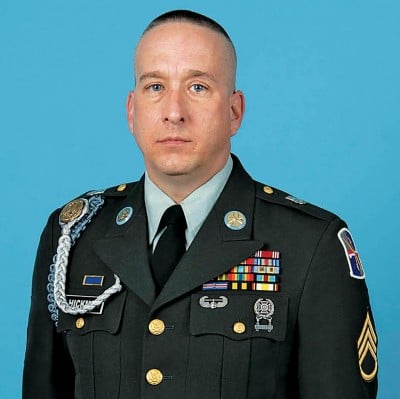Guantanamo Guard: ‘CIA Killed Prisoners and Made it Look like Suicide’

A former Guantanamo Bay guard has spoken for the first time about what he claims was a CIA murder of detainees, covered up as a triple suicide.
Army Staff Sergeant Joseph Hickman [pictured left] was on guard at the Cuban prison camp on the night they died, and calls the official version of events “impossible”.
“They would have had to all three tie their hands and feet together, shove rags down their throats, put a mask over their face, made a noose, hung it from the ceiling on the side of the cellblock, jumped into the noose and hung themselves simultaneously,” the ex-Marine told Vice News in an explosive video interview.
“In a cellblock where guards are ordered to check on detainees every four minutes.”
There had also been an inspection of the cellblock only a few hours earlier, Hickman said, and guards had found nothing detainees might use to make the nooses and rags.
Hickman tried for years to put the nightmare of his time at Guantanamo behind him, but eventually he was forced to confront his past.
He has now written a book, Murder at Camp Delta, which he hopes will be a step towards finding out the truth.
“I was trying to put Guantanamo behind me. I didn’t want to remember it. It was like a bad dream I was trying to put in the past,” he said.

Hickman says the CIA took three prisoners out of the camp and killed them. Source:AP
“Then I saw in news that another detainee had hung themself. I had to face it and see what really happened.”
On the night of June 9, 2006, Hickman was on guard at Camp Delta when he says he saw a paddywagon return to high-security Alpha Block three separate times, each time picking up a prisoner and taking them out of the camp.
He claims he watched the paddywagon take a left outside the checkpoint ACP Roosevelt, which he said would only lead to one of two places — the beach or Camp No, which we now know was a secret CIA holding facility.
“Between 11pm and 11.30pm I witnessed the paddywagon come back to Camp Delta,” he said.

The former Army Staff Sergeant says these detainees regularly incited hunger-strikes, which blocked interrogators from doing their jobs.Source:AFP
“Instead of Camp 1, it went to the medical detainee clinic. About 10 minutes later, all the lights come on, like a stadium, and sirens are going off — it’s chaos.”
The prisoners were dead.
The three men were Salah Ahmed Al-Salami, 37, from Yemen, Mani Shaman Al-Utaybi, 30, from Saudi Arabia, and Yasser Talal Al-Zahrani, 22, also from Saudi Arabia.
Al-Zahrani had been imprisoned at Guantanamo since he was captured at 17. None of the men had been charged with a crime.

It’s thought that Guantanamo inmates were regularly tortured and abused.Source:Reuters
After their deaths, Rear Admiral Harry Harris took the unusual step of attacking them in his announcement of their apparent suicide.
“They have no regard for life, either ours or their own,” he told Reuters. “I believe this was not an act of desperation, but an act of asymmetrical warfare waged against us.”
But why would the authorities want to kill these men and make their deaths look like suicide?
Hickman says it’s because the three were regular hunger strikers, who incited others to do the same.
“They had a policy that if a detainee is hunger-striking, he cannot be interrogated,” said Hickman. “In 2006, they were doing roughly 200 interrogations a week, so any massive hunger-strike would, what they consider, cripple the intelligence value.

Hickman questions how the inmates would have found the materials and escaped detection in order to hang themselves.Source:News Corp Australia
“I believe the number-one mission in JTF-GTMO (Joint Task Force Guantanamo) at the time was, stop the hunger strikes at all costs.
“I think you get rid of the people that provoked the hunger strikes and you get rid of the problem.
“After the deaths there were no hunger strikes for a long period of time.”
The ex-sergeant has spent the years since his time at the prison camp independently investigating what happened that night, and first approached the US Justice Department in 2009.
His claims, and that of others from his team, were first reported by Harper’s Magazine in 2010, provoking a major backlash, in which authorities said Hickman would have been outside the perimeter and not even able to see the entrance to Alpha Block.

A detainee is carried on a stretcher before being interrogated.Source:News Limited
There are many questions over what has gone on at the controversial facility, which still holds about 150 prisoners.
It is considered illegal under human rights law to detain people without charge, and many people say the reality of Guantanamo is the opposite of its motto: “Safe, humane, legal, transparent.”
Former inmates say the CIA regularly used torture techniques described in the recent Senate report when questioning them. They have alleged systematic abuse and former guard Brandon Neely said violence and degrading treatment was commonplace.
Hickman rejoined the army after September 11, believing it was his duty to help. “I thought Guantanamo was needed, warfare was changing and we needed a safe place to hold and interrogate them.”

Hickman believes others are afraid to speak out.Source:AP
The reality he discovered was very different.
“They scare you when you get there; they tell you you can never talk about this, it’s a classified facility. Everyone’s afraid they’re going to get in trouble.”
While Hickman has not named any alleged murderers in his book, he hopes that it will trigger a close investigation into what really went on.
“I can’t name names. I keep it vague at the end for that reason,” he says. “I say it was murder, this is the reason why.”

